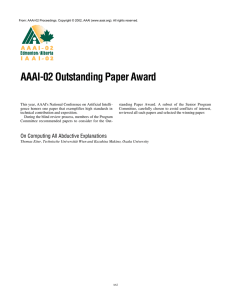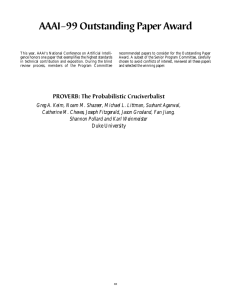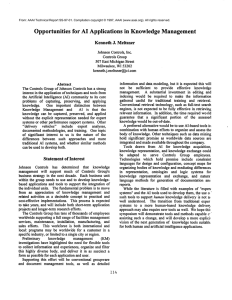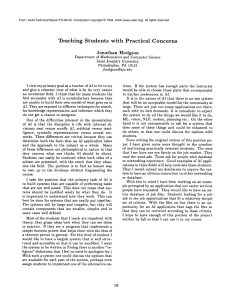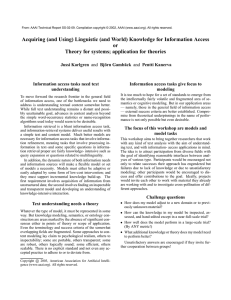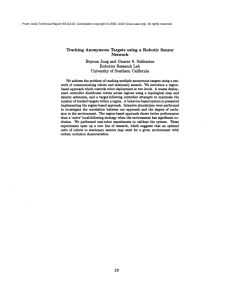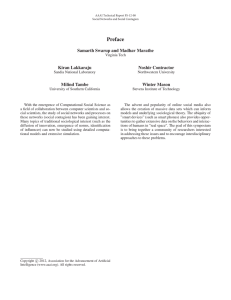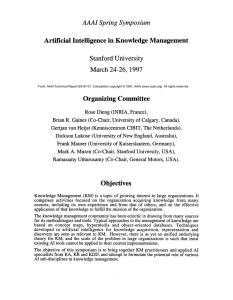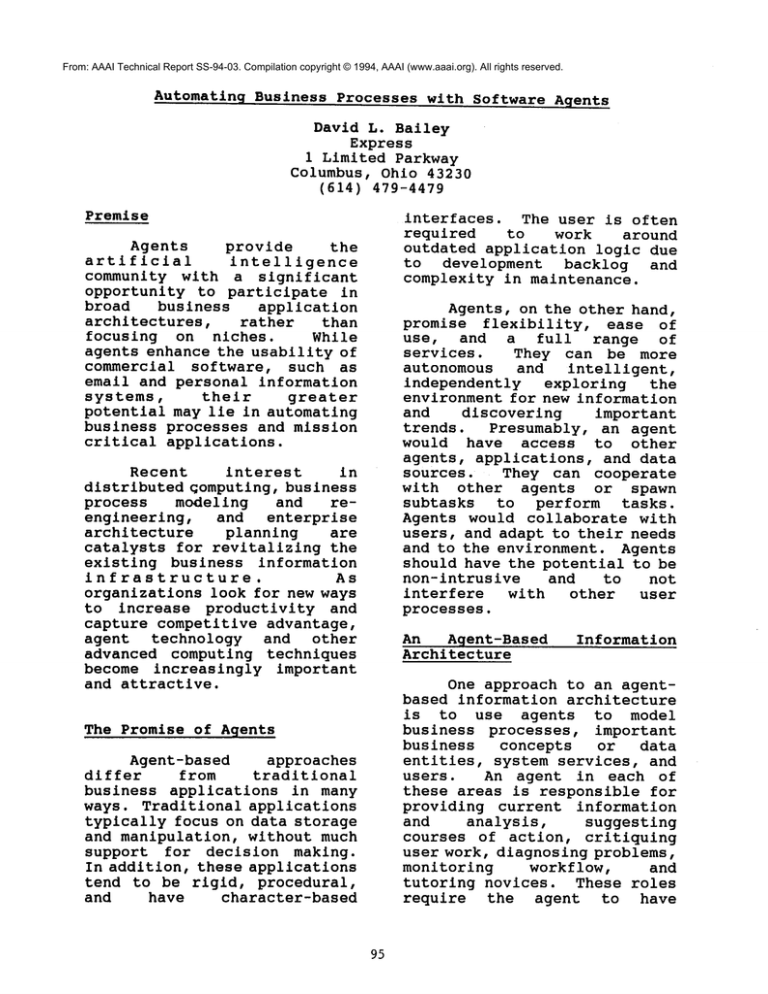
From: AAAI Technical Report SS-94-03. Compilation copyright © 1994, AAAI (www.aaai.org). All rights reserved.
Automatlnq
Business
Processes
with
Software
Aqents
David L. Bailey
Express
1 Limited
Parkway
Columbus,
Ohio 43230
(614) 479-4479
Premise
interfaces.
The user is often
required
to
work
around
outdated
application
logic due
to development
backlog
and
complexity
in maintenance.
Agents
provide
the
artificial
intelligence
community
with
a significant
opportunity
to participate
in
broad
business
application
architectures,
rather
than
focusing
on niches.
While
agents enhance the usability
of
commercial
software,
such
as
emall and personal
information
systems,
their
greater
potential
may lle in automating
business
processes
and mission
critical
applications.
Agents, on the other hand,
promise
flexibility,
ease
of
use,
and
a full
range
of
services.
They
can be more
autonomous
and intelligent,
independently
exploring
the
environment
for new information
and
discovering
important
trends.
Presumably,
an agent
would
have
access
to other
agents,
applications,
and data
sources.
They can cooperate
with
other
agents
or spawn
subtasks
to perform
tasks.
Agents
would
collaborate
with
users, and adapt to their needs
and to the environment.
Agents
should have the potential
to be
non-intrusive
and
to
not
interfere
with
other
user
processes.
Recent
interest
in
distributed
~omputing,
business
process
modeling
and
reengineering,
and enterprise
architecture
planning
are
catalysts
for revitalizing
the
existing
business
information
infrastructure.
As
organizations
look for new ways
to increase
productivity
and
capture
competitive
advantage,
agent
technology
and
other
advanced
computing
techniques
become
increasingly
important
and attractive.
The
Promise
of
An Aqent-Based
Architecture
Information
One approach
to an agentbased information
architecture
is to use
agents
to model
business
processes,
important
business
concepts
or data
entities,
system services,
and
users.
An agent
in each of
these areas is responsible
for
providing
current
information
and
analysis,
suggesting
courses
of action,
critiquing
user work, diagnosing
problems,
monitoring
workflow,
and
tutoring
novices.
These roles
require
the
agent
to
have
Agents
Agent-based
approaches
differ
from
traditional
business
applications
in many
ways. Traditional
applications
typically
focus on data storage
and manipulation,
without
much
support
for decision
making.
In addition,
these applications
tend to be rigid,
procedural,
and
have
character-based
95
knowledge
of the
business,
current
status
information,
historical
information,
and
context
from other agents.
agents
and
other
business
concept
agents.
In addition
to
extracting
concept
information
on
request,
these
agents
perform
knowledge
discovery
tasks, and monitor data quality
and
availability.
More
abstract
business
concept
agents
interact
with
data
entity
level agents to monitor
and
explore
increasingly
complex
information.
A business
process
agent
supports
the
users
,
appllcatlons,
and information
required
to perform
a business
process
such
as
product
development,
order management,
and inventory
management
and
logistics.
In order to perform
these
roles,
the
business
process
agent
would
require
business
models
and
information,
including
a:
¯
Glossary
of salient
Models
concepts
structural,
behavioral,
User
agents
are
responsible
for modeling
user
preferences
and priorities,
and
communicating
with
both
the
user and other agents.
User
agents
perform
several
tasks,
including:
terms
of
business
(static
dynamic
/
state)
Monitoring
user activity,
performing
user modeling
and
plan
recognition
functions
Model
of the
business
process
(tasks,
resource
requirements,
work
activities
and products,
a dynamic
simulation)
Accepting
requests
from the
Knowledge
resources.
Communicating
priority,
resource
allowance,
and
preference
information
to
other agents
of
information
For
example,
an agent
responsible
for
product
development
would
have
knowledge
of the process (trend
identification,
creating
prototypes,
testing
market
response,
and
so
on),
glossary
of
product,
manufacturing,
and testing
terms,
knowledge
of
the
organization
’ s policies
and
procedures,
and
a map
of
information
resources.
Ensuring
properly
presented
and
for
user
translating
information
that results
are
formatted
and
to the user.
System
agents
include
control
the
use
of system
resources,
provide
special
modeling
and
formatting
services,
and answer questions
about
the environment.
There
are several
classifications
of
systems
agent,
the most common
modeling
the operating
system
functionality.
Agents
for
business
concepts
provide
a level
of
abstraction
above
data
entities,
and are responsible
for
providing
salient
information
to business
process
96
Agent
Behavior
across
agents,
though
the
emphasis
on each component
will
vary
by the
type
of agent.
Components
include:
Agents
in
this
architecture
should
conform
to
several
social
and
environmental
laws.
Social
laws
ensure
cooperation
and
efficiency,
while environmental
laws prevent
interference
with
the user. Proposed
social laws
include :
¯
Take
turns
using
Domain
process,
user)
with
all
before
Clean
up
(delete,
(performance,
requirements)
Communicator
agent,
data,
appl icat ion)
resources,
on low priority
Analyst
trends,
Knowledge
(data,
behavior)
after
finishing
unlock, restore)
Stay out of the user’s way
(if
user
is
heavily
accessing
disk,
avoid
dlsk-lntenslve
processing)
Abide
by the
user
security
(data
application)
performing
tasks.
Agent
Self model
activities,
Planner/Estimator
(task
activities,
probability
of
success,
time to achieve,
resource
usage)
helping
Environmental
laws govern
resource
use,
security,
and
user "avoidance".
Proposed
environmental
laws include:
¯
model
availability,
access)
Motivator
( actions
are
based
on
motivations,
requests
,
and
environmental
events )
Perform
higher
priority
tasks
before
those
with
lower priority
Conserve
especially
tasks
Environment
( resource
information
resources
Share information
that ask
Do own work
others.
model
(business
business concept,
(interuser,
(current
events)
data,
discoverer
events,
own
Inferencer/Diagnostician
(business concept problem,
user questions)
Other
(peripherals,
applications,
’
s
and
when
effectors
data).
Agents
communicate
via a
logic-based
command
language
within packets
of information.
Communication
can be centrally
coordinated,
occur
through
blackboards,
or through
direct
communications
based
on an
agent-specific
model
of the
environment.
Composition
To
perform
the range
of
tasks
described
above,
individual
agents
require
several
software
components.
Several
components
are common
97
Current
Adaptation
within
agents
can occur within
the business,
user,
environment,
and self
models.
Methods
of adaptation
should
include
both inductive
and
explanatlon-based
techniques.
Issues
Agents
for
Business
Information
information
Business
incredible
agents
have
will
require
potential,
but
answers
to several
questions.
Some of the research
questions
to answer include:
We
are
pursuing
an
information
architecture
project
that
includes
identifying
business
processes
and
a number
of
the
key
concepts
supporting
business
information
agents.
We are
investigating
a number
of
advanced
computing
techniques,
including
software
agents.
My
current
work
with
agents
includes
information
gathering,
feasibility
and applicability
determination,
and conceptual
design.
How
can
agents
be
believable,
without
causing
the user to rely
too heavily
on them?
Can agents
accuracy
responses?
estimate
the
of
their
Can
agents
effectively
model
their
environment
and provide
input without
being obtrusive?
How
can
agents
be
developed
and maintained
effectively
(tools,
shells,
generic
business
components )
What
are the
tradeoffs
between
effectiveness,
performance,
and resource
usage?
Which
current
learning
techniques
are sufficient
to adapt
an agent to its
environment?
Can agents
controlled
Status
be sufficiently
and protected?
98




